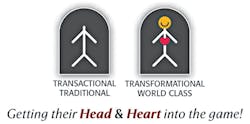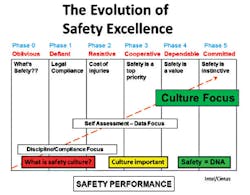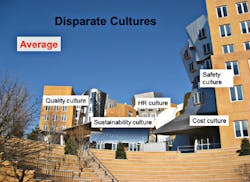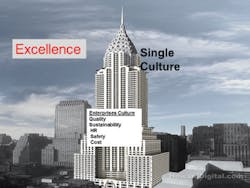Why would a seasoned safety and health professional make a statement like the title of this article? I am sure that to many safety and health professionals, this sounds like heresy.
Focusing on building a "strong safety culture" will not lead to safety excellence. It may get you to average or even slightly above average, but it won't get you to world class.
In order to achieve world-class safety performance, safety must be integrated into the culture of the enterprise. In other words, safety has to be part of the DNA of the enterprise, not something that is appended to it.
Does an enterprise have a separate HR culture, quality culture, customer service culture, etc., or are these critical elements embodied in the overarching organizational culture? Great enterprises have a single culture that includes all critical elements, including safety and health. (Authors note: When the term "safety" is used it is intended to include occupational health as well.)
There is a myriad of articles in respected publications such as EHS Today that deal with achieving a strong safety culture. By this time, with the evolution of safety moving past the unsafe conditions phase and into the emphasis on behaviors of both management and workers and a management systems approach, one would think the concept of a strong safety culture versus having safety integrated into the overarching culture of the enterprise would be passé, but unfortunately, it is not.
The culture of an enterprise is driven by the values of the enterprise, and the values of an enterprise are driven by the senior leadership of the enterprise. Therefore, safety initially must be embraced as a corporate value before it can be part of the enterprise's culture. The safety and health function of an enterprise can work tirelessly to improve safety performance, but if safety is not considered a critical or strategic value of the enterprise, these efforts will not permeate and influence the enterprise.
Organizational Culture
It is helpful to first develop an understanding of organizational culture. All organizations can be defined by their culture, which is a "system of shared assumptions, values and beliefs, which governs how people behave in an organization" (source unknown). There are numerous definitions for the term organizational culture (OC); however, the one stated above will be used because it represents the sentiment of many of the definitions we explored.
An article presented a very interesting perspective of an OC in the May 2015 issue of the Harvard Business Review. In that article, Michael Watkins stated, "Culture is the organization's immune system." He goes on to say, "Culture is a form of protection that has evolved from situational pressures. It prevents ‘wrong thinking' and ‘wrong people' from entering the organization in the first place. OC functions much like the human immune system in preventing viruses and bacteria from taking hold and damaging the body."
My point, using this analogy, is that safety antibodies must be part of this immune system, i.e., the OC. For example, suppose there is an organization where safety is not integrated into the corporate culture. It has a manager whose department excels in production but has a below average safety record, and he or she is up for promotion. There is a good chance he will get that promotion.
Now, let's look at an organization where safety strongly is integrated into the corporate culture and the same manager has the same productivity and safety performance and is up for promotion. Will he be just as likely to get that promotion? Most likely he will not, since safety is an equal partner in the corporate culture and therefore is not subservient to other key performance indicators (KPI) such as cost, quality, production, customer service, etc.
Driving H&S Excellence
When "peeling the onion," we find six or seven critical characteristics that usually are used to describe OC. One of the common characteristics has to do with the relationship the enterprise has with its people, i.e.: does it truly value the wellbeing of its people?
I was fortunate to have spent most of my professional career with Procter & Gamble (P&G). During that time, P&G's values and culture were embodied by the simple model: people, public trust and profit. What this says about the P&G culture is the employees (people)are what is valued most, then the reputation of the company and the reputation of its brands (public trust) and finally, its financial success (profit).
There is a powerful logic to this model. By valuing its people, P&G was able to install a high-performance work system that included a very high quality of work life of which safety was a significant, integrated component. P&G's business success required the company and all of its brands to have an extremely good reputation wherever they conducted business (public trust). The combination of an empowered workforce and high brand recognition would lead to economic success (profit). Safety and health plays a strategic role in each element of the model but there is no reference to "safety culture." Instead, safety and health is seen as an integral part of the key values that describe the culture of the organization.
People: Safety and health professionals recognize that protecting people both inside and outside the fence line is our primary professional and ethical responsibility. Organizational leaders need to recognize that a truly engaged workforce will deliver much better results than a workforce that is not engaged. A strong safety and health effort is required to provide the quality of work life that leads to an engaged workforce. More will be said about the role transformational leadership plays on employee engagement later.
Public Trust: This is an overarching term embracing the local and global reputation of the enterprise, as well as the reputation of its brands. It includes the concepts of integrity and high ethical standards. Workplace outcomes directly impact this. No CEO wants the enterprise or its brands to have a bad reputation.
Senior management must recognize the critical role that safety and health plays in fostering a strong company reputation and protecting the company against a bad reputation. For example, consider the public and customer relations impact when a company gets a consent decree from the EPA, a huge settlement agreement from OSHA or a breakout of an occupational disease in the workplace. These typically lead to articles in the newspapers or stories carried on national and local TV and radio.
Profit: Just a reminder that even if you work for a non-profit, you are not exempt from this final element since you would consider your budget to be akin to profit, i.e. they both are measured in $$$. Poor safety and health results directly hit the bottom line although the business case for safety and health has been poorly made by the safety profession.
Consider the impact on productivity that a serious safety incident can have. The cost of injuries might not seem like a lot, but when converted to sales equivalent dollars it gets the attention of senior management. A $10,000 incident would require an enterprise operating at a 5 percent profit margin to sell $200,000-worth of products in order to yield $10,000 to pay for the incident.
Another strategic contribution safety and health makes, but that is unrecognized by many, is that it is a technology enabler. Senior management must realize that without safety and health, the company would not be able to handle hazardous chemicals or utilize hazardous processes. Just think about it.
Transformational Leadership
Leadership can be broken down into two styles – transactional and transformational. A transactional leader focuses on the work while a transformational leader focuses both on the task and the person doing the task. A transactional leader achieves, at best, average results in any functional area. A transformational leader engages the workforce to achieve above-average results.
Engagement is the key to achieving functional excellence, be it in cost, quality, production, safety or other key performance indicators. Figure 1 depicts a very simple model of transactional and transformational leadership. The leadership style also is a component of the organizational culture. Typically, senior leadership is weighted on the transactional side but organizations focused on achieving broad functional excellence will demonstrate a balance between transactional and transformational leadership. Such an organization generally has employees who have their head and heart in the game. Again, this is an attribute of the organizational culture.
The Evolution of Safety Excellence
Figure 2 is a modified version of the Intel/Cintas Evolution of Safety Engagement Model retitled, "The Evolution of Safety Excellence."
This evolution model describes the role safety plays in the culture of the organization. In phases 0 and 1, safety simply is not present in the organizational culture. As the organization evolves to phases 2 and 3, culture comes into their stream of consciousness but they are still operating in a reactive mode. Not until an organization evolves to phases 4 and 5 does the concept of safety become part of the organizational culture.
The key is that safety transitions from being a priority (reactive) to being part of the organizational value system (proactive). This is where the cultural model previously described intersects with the evolution model. People, public trust and profit are clear values and when the organization understands how critical safety is to each one of these values, it becomes part of the organizational culture.
The Model for Safety Excellence
If a picture is worth a thousand words, allow me to use architecture to reinforce the point that a strong safety culture is not the answer if safety excellence is the goal. (See Figures 3 and 4)
The Stata building at MIT was designed by Frank Gehry (Figure 3). It simply does not work. In fact, MIT is suing Gehry since the building leaks, has cracks and is a HVAC nightmare.
This is a good model of an organization that has several disparate cultures as shown in the figure. That approach will at best achieve average performance in any of the disparate cultures, including safety.
Figure 4 is the Chrysler Building in New York. I've chosen the Chrysler Building for three reasons. The first is that I admire the art deco style and its perseverance as an architectural icon over the years. Second, as a student of safety for too many years to mention, I was fascinated that the construction of the Chrysler Building set a new standard for safety in the construction of skyscrapers. The norm (circa late 1920s –early 1930s) was one fatality for every floor over 15. Since the Chrysler Building is 77 floors, that means there could have been 62 fatalities. But there was not a single fatality. The third reason is its all-inclusive design provides a model depicting an organization with a single culture, including safety leading to excellence.
As opposed to the Stata building, the Chrysler Building functions with excellence.
Focus on Safety Integration
It is time safety thought leaders stopped writing and speaking about what can be done to achieve a strong safety culture and start focusing on how organizations can integrate safety into the overarching culture of the organization. I realize this is much "heavier lifting" than they may want to do, but it is essential if safety excellence is the goal.
My objective is to be a bit provocative and start a dialogue about where safety fits in the culture equation. I work with Cintas, the uniform rental company, which is making progress in its safety journey to excellence.
When we started, safety was not a part of its corporate culture. However, to demonstrate not just its progress but truly to distill down to one sentence what this article is about, here is a quote from its CEO, Scott Farmer:
"Safety must be something much more that a subject we manage. It will become part of our corporate culture and will be a foundational part of everything we do as a company."
Dr. Richard D. Fulwiler is president of Transformational Leadership Associates, a consultancy that focuses on organizations achieving functional excellence. He also is an instructor at the Harvard School of Public Health and co-director of their leadership and management course. He can be reached at 513-476-0811 or by e-mail at [email protected].




